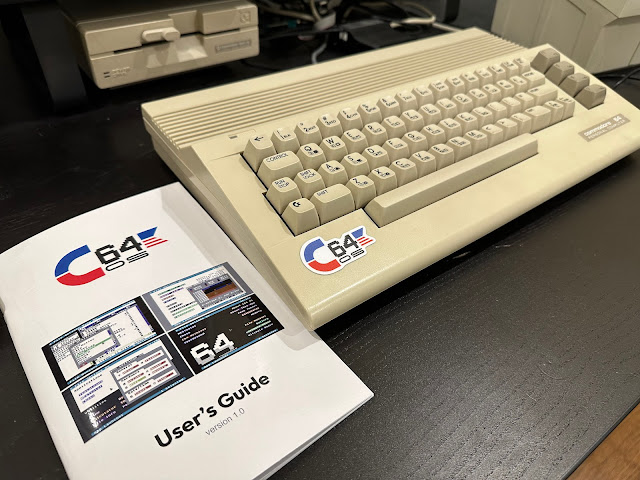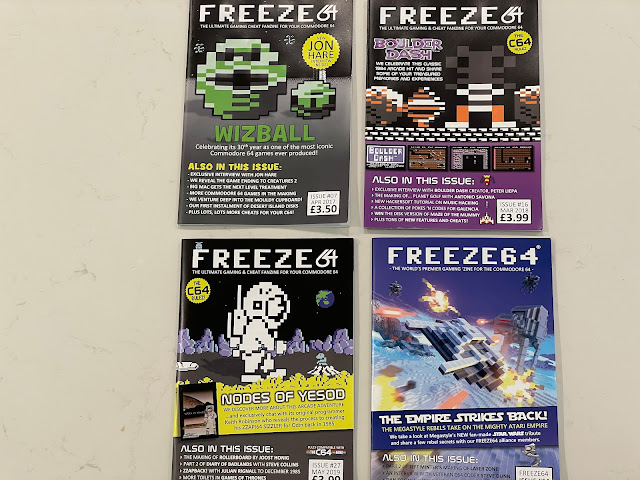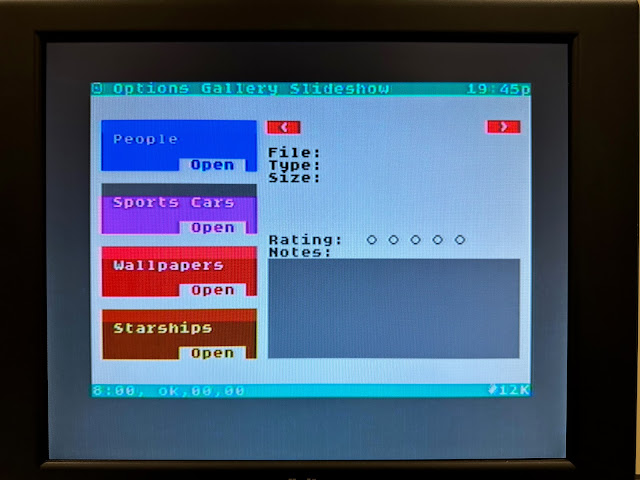New C64 OS on Commodore 64
For my final blog post of 2022, I decided to take a quick look at the recently released C64OS from OpCoders, a brand new operating system for the Commodore 64!

The Combo cartridge is in a 3D printed customised cartridge shell, obviously to fit the sd card slot, and the buttons around it. It doesn't look that great in black - there were other colours in the past, but all out of stock when I ordered it. So black it is!
There was also a nice instruction sheet included, showing how to get started, and also how to change the Drive ID if you plan to use another disk drive at the same time.
Next, I prepped the SD Card as per the instructions. as I use SD2IEC solution (with special custom connector) on my Commodore Plus/4 computer, I could copy that SD card, and just add the C64 software to it.
I then loaded the FB menu program on the prepared SD Card so I could check the SD2IEC functionality works as expected.
The manual included is a quickstart User's Guide manual as below, and a sticker too.

That done, I put it back in the SD2IEC combo cartridge, and loaded the directory of the SD Card so I can open the setup process for the C64 OS.
While starting work on the setup work, I pulled out the soundtrack CD of Polar Bears in Space, a recent game I purchased for the Commodore 64, which was included in the box. I love that the CD label looks like a real record.
I then fired up the FM Towns, which is near the C64, so I could listen to the wonderful SID music from this C64 game while I worked on the setup of C64OS!
Getting a new C64 game with a Record purchase was really cool too:

This launches the C64OS Setup tool:
I then agreed with the terms and conditions and opened up the user guide to follow the instructions carefully.
This part is quite important, as it sets the drive number for C64OS to use, which is set to whatever Drive number the SD2IEC is set to. In my case, this is 8. If I had daisy chained a real floppy drive with drive 8 on it, I would need to change the Drive number on the SD2IEC board, by opening the cartridge to change a jumper. I don't need to do this, so let's move on.
I chose a fresh installation, since this is the first time I am setting it up. The installation then proceeds with the setup and this takes quite a long time to complete, so definitely time for a coffee.
While waiting, I read through some more of the manual, getting familiar with the user interface of C64OS and some of the key concepts.
I can then run the configure tool, to choose the mouse input and other initial settings for the user interface of C64OS.
I walk through the questions the configure tool asks. Important one is the mouse - if you don't have a mouse, make sure to choose joystick to control the mouse pointer.
You then get the option to change the default keyboard shortcuts. I didn't change them, but it was useful to see what they are.
I have an Amiga mouse, but not a 1351 mouse (or a converter for one), so I needed to choose joystick here.
I used the default Go-Menu places configuration to start with. With that done, the configuration of C64OS is complete, and ready to try.
On boot of the c64, just LOAD"C64OS", 8 and then RUN to start it. It takes a short while to boot up C64OS. Fastload definitely helps.
There are menu items File, Options and Go are at the top in the title bar, along with the date/time on the right hand side. I use my joystick as the mouse to navigate and press fire on the option I want to select. I really want to get a 1351 mouse now...
Under the File Menu, you can see the options to change/save backdrops, Add aliases to programs on the SD card, to appear on the desktop, and copy and move functions too.
Under the Options menu, you can select everything on screen, get information about an application, adjust the colours on the screen, save the settings that you have altered, and Quit back to C64 Basic.
Under the last menu Go, you can change which desktop you are looking at! That's right, C64OS support multiple desktops, like Linux, MacOS and other modern operating systems! You can also launch the file manager from this menu.
If you click on the Drives App alias on the Desktop, you can choose the SD2IEC SD Card, or an actual floppy drive to view. You can also eject SD Cards from here. I don't have a real floppy drive attached to be able to test that (due to the cable length mentioned before). You can also Rescan if you have inserted a disk.
The Calculator App on C64OS is quite impressive too, with the usual scientific and standard calculator functions.
From the Themes App alias on the desktop, you can choose from a few standard themes available in C64OS, or customise your own.
Included with C64OS is a number of different galleries based on People, Sports Cars, Wallpapers and Starships.
I selected Sports cars, and it shows the picture information for the first of ten photos in this gallery.
The files are in a .koa format. I need to learn more about that so I can put my own pictures in here later!
You can infinitely pull up/down the picture from the status bar section, showing the full picture or part of the picture information screen. Very impressive.
I learnt the keyboard shortcut to display full screen, without needing to drag the status bar up each time to see the picture.
It allows up to 4 tabs, each showing different locations, and able to copy between them too. Very nice.
If you double click on an item, if it associated to an App on C64OS, it can then open it also. There are some SID music files on here so I thought it would be able to play them.
Turns out it is not as simple as that - File Manager asks me what app to use to open the sid file, which means it is not associated to anything. I know that playback of sid files is tricky with an OS loaded also. I would like to know how to play these from C64OS though. The SID files are included so I assume there is a way to play them right?
I am looking forward to learning a whole lot more about this new exciting operating system for the Commodore 64. There is an excellent Youtube video here that covers some more of the customisation you can do in more detail than I have done here today. Hopefully I have given you a taste to whet your appetite to get it and find out for yourself!
I wanted to write more about C64OS, but I ran out of time, so that will have to wait for 2023!
2022 has been a great year, with a lot of amazing software and hardware released. I have tried to cover what I can in this blog this year, but there is a lot more out there to see! It is fun being able to cover all these new exciting developments for C64, Amiga and other platforms too. I have now been doing this blog for over 10 years!

I hope you have enjoyed my blog entries during the year.
























































